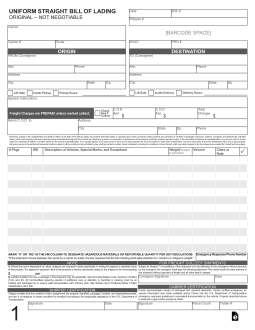Updated June 25, 2024
A bill of lading is a document used to ship goods by freight. It serves as a contract between the sender and the shipping company that describes the contents of the shipment and identifies the origin, destination, and the parties involved. The bill of lading accompanies the freight throughout the shipping process to serve as a receipt, proof of shipment, and ultimately as title to the goods being transported.
When is it required?
According to the Code of Federal Regulations, all common carriers, except express companies, engaged in the transportation of property other than livestock and wild animals, by rail or by water are required to use a bill of lading.
Table of Contents |
Required Information
The format and layout of a bill of lading can vary. Shippers and carriers typically use their own forms, and commercially available templates will differ from one to the next. However, the Federal Code of Regulations requires, generally, that a bill of lading includes the following information:[1]
- Names of consignor and consignee (shipper and receiver)
- Origin and destination points
- Number of packages
- Description of Freight
- Weight, volume, or measurement of freight (if applicable to the rating of the freight)
Identifying Hazardous Materials
Hazardous materials must be identified as the first items in the freight description on a bill of lading. The Department of Transportation requires that specific information is included in the description, and they provide compliance guidance for shippers and carriers.[2]
Hazardous materials include:
- Explosives
- Gasses
- Flammable solids and liquids
- Oxidizers and corrosive materials
- Poisonous and infectious substances
- Radioactive materials
It should be noted that some household goods, electronics, and appliances contain hazardous materials that must be identified. An extensive list of hazardous materials by name is provided in the Code of Federal Regulations Table 172.101
Types of Bills of Lading
There are many types of bills of lading, each having a specific purpose. Some important factors that determine which to use are:
- Shipping method (land, sea, or air)
- Carrier preference (depending on workflow)
- Origin and destination (domestic or international)
- Negotiable or not-negotiable (whether goods are transferrable or not)
For domestic freight shipments, and some international shipments, the most common type of bill of lading is the uniform straight bill of lading. Required by law, it is used in most cases, regardless of shipping method and is accepted by all carriers.
Uniform Straight Bill of Lading
Federal law requires the use of this type of bill of lading (or the less common “uniform order bill of lading”) for domestic interstate freight shipments.[3] The law specifies the format and information to be included on the form as well as detailing the contract that is created between the shipper and carrier when it is used.[4]
Many shipping companies have a proprietary version of the form that is typically provided for free to their customers. Blank versions of the document are also available for sale on eCommerce sites and at office supply stores.
FAQs
Who issues a bill of lading?
Technically, the shipping company (or carrier) issues a bill of lading. However, issuing a bill of lading is different from creating a bill of lading. Shippers must provide details about the goods before the carrier can issue the BOL. In many cases, the shipper provides the carrier with a bill of lading that includes details about the origin, destination, and freight. Once the freight is loaded, the carrier will complete the BOL and “issue” it.
Who is the “Consignee” on a bill of lading?
The Consignee is the receiving party. This is the person or company that the freight is being shipped to.
What date should be entered on a bill of lading?
The date on a bill of lading should be the date that the freight was loaded. If loading takes multiple days, the date should reflect the day that the loading was completed.
What is the bill of lading number?
The bill of lading number is generated by the shipping company. It is a unique number that identifies the shipment. The format for a BOL# or B/L# is four letters followed by eight, ten, or twelve-digit code. Example: ABCD12345678


